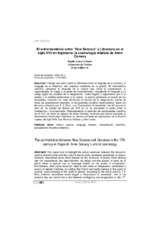Mostrar el registro sencillo del ítem
El enfrentamiento entre “New Science” y Literatura en el siglo XVII en Inglaterra: la cosmología vitalista de Anne Conway
| dc.contributor.author | García Calderón, Ángeles | |
| dc.date.accessioned | 2018-02-12T09:00:53Z | |
| dc.date.available | 2018-02-12T09:00:53Z | |
| dc.date.issued | 2013 | |
| dc.identifier.issn | 2255-3703 | |
| dc.identifier.uri | http://hdl.handle.net/10396/16127 | |
| dc.description.abstract | Trabajo que versa sobre la diferencia entre el lenguaje de la ciencia y el lenguaje de la literatura, con especial incidencia en la poesía. El racionalismo científico denigrará el lenguaje de la poesía que utiliza lo sobrenatural, lo imponderable, la magia y el poder de encantamiento, manejando el lenguaje a su antojo según los poderes de la imaginación. Locke llegará a argumentar que si la verdad y la realidad pertenecen a la ciencia, la poesía pertenece al mundo de los fantasmas, minando con esta afirmación el mundo de la imaginación, fuente de todas las aberraciones mentales. El racionalismo científico desencadena, según los términos utilizados por T. S. Eliot, una “Dissociation of sensibility”, de ahí que en la obra de los poetas de finales del XVII ya no se encuentre la unión entre la inteligencia y la imaginación. Representando la posición del racionalismo científico en el XVII, se traza un esbozo de Anne Conway, escritora que estuvo asociada al denominado Cambridge Platonists, la tercera corriente en importancia de la filosofía inglesa del siglo XVII, tras Thomas Hobbes y John Locke. | es_ES |
| dc.description.abstract | This paper tries to highlight the actual variations between the discourse used in scientific texts and that used in literary texts, and more specifically, in poetry. Scientific rationalism would show disdain on the discourse of poetry when dealing with the supernatural, the imponderable, the magic and the powers of spell, all of which mean a special use of language based on the power of imagination. Furthermore, John Locke would be ready to look down on imagination, considered a source of mental madness, by stating that if truth and reality belong to the world of science, poetry belongs to the world of ghosts. According to the terms used by T S Eliot, scientific rationalism would trigger a “dissociation of sensibility”, one of the reasons why we cannot find a link between intelligence and imagination in late 17th century poetry. As a leading figure of scientific rationalism, Anne Conway is a writer who joined the third most important movement of the 17th century English philosophy, namely the Cambridge Platonism, together with other prominent figures like Thomas Hobbes and John Locke. | es_ES |
| dc.format.mimetype | application/pdf | es_ES |
| dc.language.iso | spa | es_ES |
| dc.publisher | UCOPress | es_ES |
| dc.rights | https://creativecommons.org/licenses/by/3.0/ | es_ES |
| dc.source | Skopos 3, 49-62 (2013) | es_ES |
| dc.subject | Nueva ciencia | es_ES |
| dc.subject | Lenguaje literario | es_ES |
| dc.subject | Racionalismo científico | es_ES |
| dc.subject | Pensamiento filosófico femenino | es_ES |
| dc.subject | The New Science movement | es_ES |
| dc.subject | Literary language | es_ES |
| dc.subject | Scientific Rationalism | es_ES |
| dc.subject | Female philosophical thought | es_ES |
| dc.title | El enfrentamiento entre “New Science” y Literatura en el siglo XVII en Inglaterra: la cosmología vitalista de Anne Conway | es_ES |
| dc.title.alternative | The confrontation between New Science and Literature in the 17th century in England: Anne Conway’s vitalist cosmology | en |
| dc.type | info:eu-repo/semantics/article | es_ES |
| dc.relation.publisherversion | https://www.uco.es/ucopress/ojs/index.php/skopos/index | es_ES |
| dc.rights.accessRights | info:eu-repo/semantics/openAccess | es_ES |

